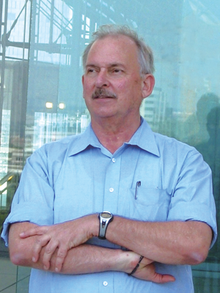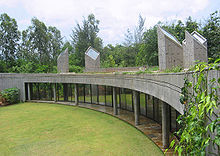- Christopher Charles Benninger
-
Christopher Charles Benninger 
Born November 23, 1942 Nationality American-Indian Work Practice CCBA Buildings Mahindra United World College, Suzlon One Earth, India House Christopher Charles Benninger is an American-Indian architect and planner born in the United States in 1942. He studied urban planning at the Massachusetts Institute of Technology and architecture at Harvard's Graduate School of Design, where he later taught (1969–72).
Benninger studied under Josep Lluis Sert and worked in his studio. He was a protege of the noted economist Barbara Ward and a member of the Delos Symposium group, contributing articles to the journal Ekistics. He was influenced by the group's founder, Constantinos Doxiadis who led the Ekistics movement. This brought him into association with Buckminister Fuller, Arnold Toynbee, Margaret Mead and Jaquline Tyrwhitt.
On the invitation of B. V. Doshi, in 1971 he resigned from his tenured post at Harvard and shifted to Ahmedabad, India as a Ford Foundation Advisor to the Ahmedabad Educational Society, where he founded the School of Planning.[1] In 1976 he shifted to Pune, India, where he founded the Center for Development Studies and Activities.[2] In 1983 Benninger wrote the Theme Paper for the United Nations Commission on Human Settlements 1984. In 1986 he was engaged by the Asian Development Bank to author their position paper on Urban Development, arguing successfully the case for extending financial assistance to the urban development sector. Benninger is on the Board of Editors of CITIES journal (UK),[3] and on the Board of the United States Educational Foundation (Fulbright Foundation) in India. He is a Distinguished Professor at the Centre for Environmental and Planning Technology University, Ahmedabad,[4] and on the Board of Governors of the School of Planning and Architecture, New Delhi.
While in Ahmedabad he innovated the concept of Site and Services, an approach to housing providing access to shelter via developed small plots, allowing poor families to construct their own homes, according to their means. For the World Bank and the Madras Urban Development Authority 1973 he designed over 20,000 such units in four locations, the largest being at Arambakum in Chennai. With the advent of institutional housing finance in India 1972 he created a unique neighborhood of small ground level houses for about five hundred households in Jamnagar, Gujarat. This was the first shelter program funded by the Government of India for the economically weaker section of society. In 1976–79, using funding from the Housing and Urban Development Corporation (HUDCO), he built a township for low income households at Yusafguda, in Hyderabad with over two thousand houses, public amenities and shopping centres. This was the first project of the Hyderabad Urban Development Authority and provided owners with road access, street lights, storm drains, electricity and sanitary cores. Around these core facilities low income families could construct their own houses. For the World Bank and the Calcutta Metropolitan Development Authority, Benninger was part of a team that devised the (slum) Busti Improvement Program. This approach brought sanitation, potable water, electricity, storm drains, paved lanes with street lighting and community services to millions of low income citizens of Kolkata.
Contents
Works
Benninger's best known architectural works are a cluster of academic and educational campuses in the mountainous region between Mumbai and Pune in India. These include the Center for Development Studies and Activities, the Mahindra United World College of India, the Samundra Institute of Maritime Studies, the YMCA International Camp, Nilshi, India, the Kirloskar Institute of Advanced Management Studies and the International School Aamby. The Centre for Life Sciences Health and Medicine in Pune is a radical departure from his earlier work.[5] Other important works are the Kochi Refineries Corporate Headquarters in Kerala, the Alliance Francaise in Ahmedabad and SOS Children's Villages in Kolkata and Bawana outside of Delhi. The new campuses for the Indian Institute of Management, Calcutta and the College of Engineering, Pune are nearing completion. Benninger was recently awarded the Azim Premji University in Bangalore and the Bajaj Institute of Technological Studies in Wardha where he has built the Bajaj Science Centre.
The Mahindra United World College of India won international recognition as the recipient of the Business Week/Architectural Record Award for Excellence in the year 2000. This Award was sponsored jointly with the American Institute of Architects. Business Week called the Mahindra United World College of India one of the ten super structures of the world in the year 2000.[6] The project also won the Designer of the Year Award [7] in 1999. The Kochi Refineries Headquarters Building won the award as one of India's two best office buildings in 2005, sponsored by the Indian Architect and Builder "awards for working spaces".
 Camp Managers Bungalow at YMCA International Camp, Nilshi, India
Camp Managers Bungalow at YMCA International Camp, Nilshi, India
The YMCA International Camp, Nilshi, India won the Archies Award for the best Institutional Building 2006 and the Indian Institute of Architects Award for the Best Public Building 2006. The British Society for Design and the Architecture Plus Design journal awarded Benninger the Recognition in Design (RED) Award as the Best Architect in India in November 2006. This was the first RED award given in India. His building Samundra Institute of Maritime Studies was selected for the Indian Institute of Archietcs as the Best Public Building for the year 2008 and by the J. K. Cement Awards as the best Institution in the year 2009. It won the Institute of Structural Steel Design and Growth Award 2009 as one of the two best steel structures in India.
Benninger's planning work includes development plans for six regional capitals in Sri Lanka, three new towns in Bhutan, the Development Plans of Kalyan and Thane in the Mumbai Metropolitan Region, the plans for twenty-eight urban centres in Madhya Pradesh and the Capital City of Bhutan, Thimphu. For Nepal he designed their decentralized planning methodology 1989 and for Indonesia their Shelter Sector for the Indonesian National Rural Development Program 1979-81. Benninger guided the planners of the Katenga Regional Development Authority in their design of the new economic region in Terengganu, an emerging region in the North-eastern region of Malaysia. Benninger's work in urban design, city management and town planning resulted in his Principles of Intelligent Urbanism, which guided his planning of the new capital of Bhutan.[8]
Architectural works in progress include the new campus for the Indian Institute of Management Calcutta; the Indoor Air Conditioned Stadium at Ahmedabad; The Governance Center at Hyderabad and second campus of KIAMS at Pune.Suzlon One Earth, of the Suzlon Wind Energy Company, India House, new studios for Christopber Charles Benninger Architects were completed recently.
The studio in Bhutan has completed Tshechu Ground, a major ceremonial plaza and pavilion for the annual National Buddhist festival and the coronation site for the Fifth King;and the Supreme Court of Bhutan; and the first four of the ten Secretariat Ministries that will form the National Secretariat Complex are under construction. The Bhutan Studio is also designing the new UN HOUSE in Bhutan.
Awards
In April 2010 Professor Benninger was awarded the Architect for the Decade Award his contribution to the profession of architecture over that period. Over the past four years, on three occasions, the Indian Institute of Architects has honored him with the award of Best Public Building of the Year for his designs of the Centre for Life Sciences, Health and Medicine, the YMCA International Camp, Nilshi, India and for the Samundra Institute of Maritime Studies. The design for Suzlon One Earth has been honored by the Architects, Engineers, Surveyors Association of Pune as the Best Architectural Work in the City in 2009 and it was recently named the Most Sustainable Building in India, in a national competition. It is a LEED Platinum and Five Star Teri Griha building.Christopher Benninger is currently the sixth winner in India of the Golden Architect Award for Lifetime Achievement (2006) that was conferred in May 2007 by the A+D and Spectrum Foundation.[9] Over the past seventeen years, six Indian architects have been honored with the Great Master's Award,[10] and in 2007 Professor Benninger became the seventh awardee. Over several years he was recognised as one of the top ten architects in India by Construction World Magazine.[11] His firm, Christopher Charles Benninger Architects, has a team of thirty-five professionals with studios in Pune and Thimphu, where he is designing the new Capital Complex. He has associated a group of technical consultants in New Delhi, Mumbai, Bangalore and Pune in the areas of structural, services, landscape and interior design. CCBA offers comprehensive architectural services from design through supervision. In recognition of his contributions to the architectural and planning professions in India, Christopher Charles Benninger has been honored as the first recipient of the (RED) Recognition of Excellence in Design Award (2006). This was conferred by the Royal Society of Designers and Architecture Plus Design journal in India on an Industrial Designer, on an Interior Designer and on an architect.
Books
On the 9th of May, 2011, at the Center for Architecture in Manhattan, an event, sponsored by the American Institute of Architects, was held for the release of LETTERS TO A YOUNG ARCHITECT written by Christopher Benninger. The book was published by Createspace and was also released by Kindle in a digital version. Benninger's work can be found in other books such as The Urban Fringe in Indian Cities (2011); Timeless Inspirator (2010); Economics, Development and the Quest for Alternatives (1997);Politics of Modern Maharashtra (2000); and Conflict Resolution Through Non-Violence(1990).
See also
- Ekistics
- Mahindra United World College of India
- Principles of Intelligent Urbanism
- Samundra Institute of Maritime Studies
- Suzlon One Earth
- YMCA International Camp, Nilshi, India
References
- ^ Lang, Jon T., A concise history of modern architecture in India, 2002, Page 45
- ^ Archpresspk.com
- ^ Elsevier.com
- ^ Spcept.ac.in
- ^ G-therapy.org
- ^ Businessweek.com
- ^ Archlib.njit.edu
- ^ Dudh.gov.bt
- ^ Propertybytes.indiaproperty.com
- ^ Expressindia.com
- ^ Constructionupdate.com
External links
- Official website
- Benninger to design Azim Premji University
- Interview
- Interview in Architimes. Pakistan
- Interview - Mastermind
- Article- Pune:City of My Dreams
- Article: Bringing in the new Pune
- Article:The great city builders
- Master-of-concrete-dreams - Article : Indian Express
- We Live by his Rules - Article : Indian Express
- Video: Interview of BV Doshi by Christopher Benninger
- Interview of Christopher Benninger: Architects must be like teachers
- Mahindra United World College
Categories:- 1942 births
- Living people
- Urban planners
- Indian architects
- Harvard University alumni
- Massachusetts Institute of Technology alumni
- Harvard University faculty
Wikimedia Foundation. 2010.



